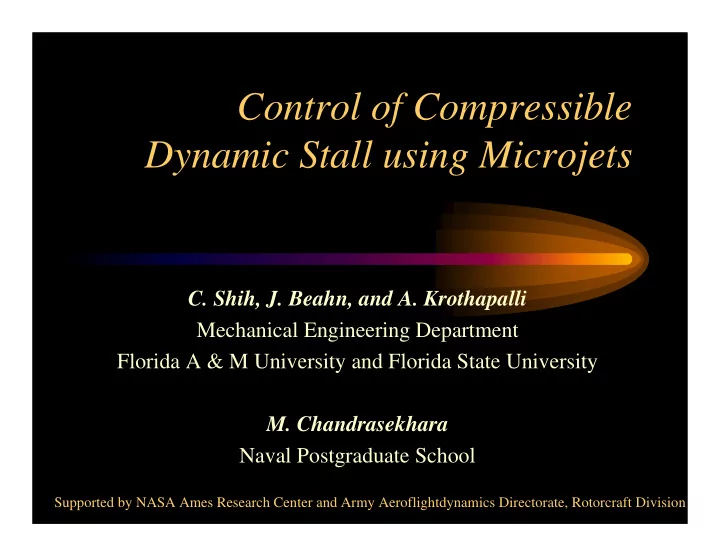

Control of Compressible Dynamic Stall using Microjets C. Shih, J. Beahn, and A. Krothapalli Mechanical Engineering Department Florida A & M University and Florida State University M. Chandrasekhara Naval Postgraduate School Supported by NASA Ames Research Center and Army Aeroflightdynamics Directorate, Rotorcraft Division
f mrl luid mechanics research laboratory Outline • Motivation • Experimental Setup – Point Diffraction Interferometry (PDI) • Dynamic Stall with and w/o Control • Physical Mechanism/Control Strategy • Conclusion
f mrl luid mechanics research laboratory Dynamic stall: a flow phenomenon when wings and rotors experience sudden changes of their operating conditions (angle of attack, inflow conditions, etc). The flow response to these changes usually involves many adverse effects such as massive boundary flow separation, a loss of lift, drag surge, and buffeting. Massive Separation Stall Stall Flow/Structure Buffeting drag lift α α time
f mrl luid mechanics research laboratory Program Objectives • Eliminate or minimize these adverse effects using microjets • Devise control strategy to achieve the optimum efficacy Previous control efforts • Boundary layer blowing & suction, synthetic jets, pulsed vortex generator jets • Nose modification • Mechanical devices: vortex generators, flaps & slats
f mrl luid mechanics research laboratory Experimental Setup • NACA 0015 airfoil • Blow-down wind tunnel – Operate at Mach 0.3-0.4 • Pitch rate: k=0.05 & 0.1, pitch angle: 5 to 25 deg. • Reynold’s number – 1.06 - 1.40 x 10 6 • Point Diffraction Interferometry (PDI)
f mrl luid mechanics research laboratory Experimental Setup - Airfoil • 424 microjets (8 rows) on upper surface for 10% chord – 400 µ m in diameter – Continuous blowing straight up • Mass Flow Rate: 0.03 kg/s @ 22 psia Plenum pressure Airfoil Leading Edge • Blowing momentum ratio (C µ ): 0.01 to 0.02
f mrl luid mechanics research laboratory Advantages of using the microjet control as compared to other existing control techniques • Non-intrusive: no external mechanical device is required; provide no disturbance to the flow. • Adaptive: can be turned on and off as needed. • Easy to implement: mass bleeding flow is generally available in helicopters and airplanes. • Simple and in-expensive: no complicated hydraulic/mechanical mechanisms are necessary.
f mrl luid mechanics research laboratory PDI Technique • Modified Z-shaped Schlieren system with coherent laser source • Passing through flow field of interest, re-focus expanded laser column into spot through a semi-transparent holographic plate with a pinhole – Separates light source into Signal and Reference beams – “Cleans up” Reference beam through pinhole sample image
f mrl luid mechanics research laboratory Interferogram Images Viscous Bright and dark Shear fringes Layer Separation Region Suction Peak Stagnation Point
f mrl luid mechanics research laboratory Typical Results M=0.3, k=0.05, a=20 deg. Massive Separation microjets No control With control • With control, the buffeting noise due to Flow remains attached the wake shedding is drastically reduced.
f mrl luid mechanics research laboratory Flow Sequence, M=0.3, k=0.05 No Control α =11.5 o upward α =15.9 o upward α =19.9 o upward With Control
f mrl luid mechanics research laboratory Flow Sequence, M=0.3, k=0.1 No Control α =15.9 o upward α =18.0 o upward α =20.0 o (apex) With Control
f mrl Surface Pressure Distribution M=0.3, k=0.1, α =20 deg. luid mechanics research laboratory Pressure Distribution M=0.3, k=0.10, α =20.0 deg upward x/c -5 -4 -3 -2 C p -1 0 0.05 0.1 0.15 0.2 0 Recovery of the leading edge peak 1 suction pressure with control 2
f mrl Peak Suction Pressure luid mechanics research laboratory M=0.3, k=0.1 Min C p versus angle of attack M=0.3, k=0.10, NC & WC (21.7psia) -6 Reduce hysteresis due to control -5 Minimum C p -4 -3 -2 Loss of lift at low AOT -1 More drastic drop in lift due to control without control at high AOT 0 12 13 14 15 16 17 18 19 20 Angle of Attack (deg)
f mrl Shock-Induced Separation luid mechanics research laboratory M=0.4, k=0.05 Periodic λ shock structure Thickening boundary layer Triggering separation α =12.5 o α =10.4 o α =14.5 o
f mrl luid mechanics research laboratory Effect of Microjet Control M=0.4, k=0.05, α =20 deg. Release of dynamic No massive separation stall vortex No vortex No Control Microjet Control
f mrl luid mechanics research laboratory Shock Elimination M=0.4, k=0.05 “ λ ”-shocks
f mrl luid mechanics research laboratory Physical Mechanism Leads to the Formation of a Vorticity Accumulation and the Initiation of Dynamic Stall Vortex ⇒ the Unsteady Separation Process (Van Dommelen & Shen) and/or Shock-Induced Catastrophic Breakdown, Lift Loss, Separation ⇒ Explosive Vorticity Eruption Drag Surge, Moment Stall • Mismatch of time scales • Vorticity accumulation due to an unbalanced vorticity generation, diffusion, and convection
f mrl Control Strategy luid mechanics research laboratory � Tradition Schemes on Separation Control • Relieve the adverse pressure gradient (nose modification..) • Re-energize the boundary layer (suction, blowing, vortex generators..) � Our Approach: Controlled Separation • Eject vorticity away from the surface at a controllable manner using distributed microjets Controlled, distributed ejection of surface Increase downstream convection of vorticity ⇒ redistribution of the vorticity vorticity ⇒ No accumulation ⇒ More through ejection manageable breakdown process
f mrl luid mechanics research laboratory Summary � Dynamic stall has been significantly reduced or eliminated ⇒ improve aerodynamic performance � Pressure recovery ⇒ an increase of lift � Elimination of the shocks at the leading edge ⇒ alleviating the possibility of the shock-induced separation � Suppression of the periodic shedding of the dynamic stall vortices ⇒ reduce buffeting noise and associated vibration
f mrl luid mechanics research laboratory Future Work • Obtain pressure distribution, lift, and drag measurements to quantify the effectiveness of control • Reduce control mass flow rate: consider activation of control on an “as needed” basis • Optimize flow control parameters: pressure, distribution pattern, jet angle, pulsating blowing • Apply control to scaled-down helicopter rotor blades
f mrl luid mechanics research laboratory Thank You
Recommend
More recommend